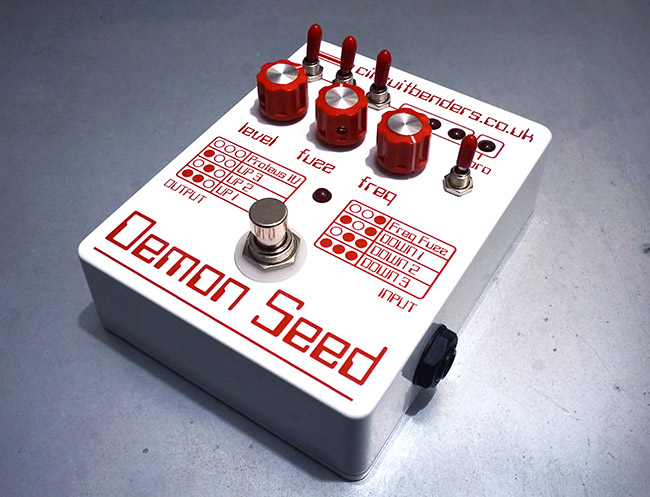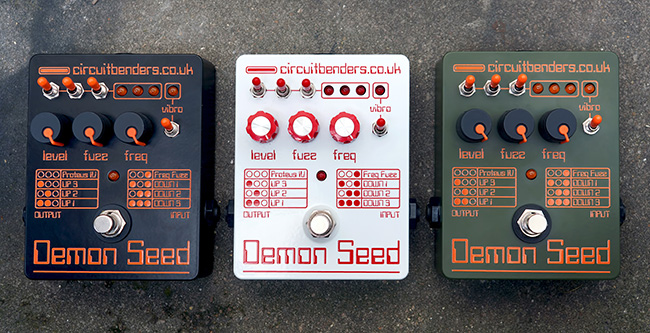DEMON SEED PEDAL: £115
If we have any of these in stock they are only available in our ETSY shop.
The circuitbenders.co.uk Demon Seed is a fuzz / distortion / frequency shifting / 8-bit / lo-fi / filth pedal that makes noise in quantities more than enough to constitute a crime against humanity.
It utilises the Holtek HT8950 voice changer chip that was designed specifically for use in toy robot voice changer megaphones. The HT8950 converts the analogue guitar signal to 8-bit digital, applies 6 selectable types of frequency shifting or a weird robot arpeggio effect, and then converts the digital signal back to analogue again.
Before someone points it out... yes inevitably this pedal was to some degree inspired by the excellent Death By Audio 'Robot' pedal, but its difficult to not be when using the HT8950, and this pedal has the addition of several features that the HT8950 chip offers but the Robot pedal doesn't use. The Robot is the original HT8950 pedal. All hail Death By Audio!

The controls are:
Level: Unsurprisingly this sets the output level of the pedal.
Fuzz: This controls the level of disgustingly distorted filth applied to your guitar sound. It may seem as if its a bit 'all or nothing', but you will find that rather than adding more distortion after a certain point round the dial the sound will start to compress, adding sustain to notes that would otherwise crumble away due to having insufficient signal level for the HT8950's 8-bit analogue to digital converter to work with. For the same reason depending on the output level of your pickups at lower fuzz settings the signal will start to gate.
The fuzz works by massively overloading the opamps on the input stage of the HT8950, which is designed for tiny signals sourced from the kind of electret condenser microphone you find in thousands of toys.
Freq: This controls the clock speed of the HT8950. As a result it will also control the sample rate and bandwidth of the 8-bit analogue to digital converter, and introduce various sample aliasing effects depending on the setting. This is very similar to effects you would find on a bit crusher, but actual 8-bit digital aliasing instead of the emulation that many bit crushers use. The cleanest or most focused version of any of the effect modes is often to be found at the highest frequency setting.
The clock speed will also control the speed of the 'Proteus IV' robot arpeggio effect, and the rate of the 'vibro' vibrato.
Vibro: This switch activates the so called vibrato effect offered by the HT8950 chip. In practice its only really a vibrato at higher frequency settings and with one of the 'UP' effects activated. At lower frequency settings it starts to do something quite unpleasant, and with the Proteus IV robot mode activated things start to get very odd.
Due to the fact that the HT8950 is intended to be used in battery powered kids toys the on-chip vibrato effect is implemented electronically in a slightly odd and sometimes unreliable manner. On some rare occasions such as when the pedal has been powered off and back on very quickly with the vibrato turned on, you may find that the effect goes out of sync with the indicator LED and becomes activated when the LED is off, and vice versa. You may not ever encounter this issue, but if you do just power the pedal down, turn off the 'vibro' switch and power it up again. This should reset things so the LED actually indicates the effect being on or off.
Footswitch: You can probably work that one out yourself.

The three switches at the top left are the effect mode controls. When each switch is activated it turns on a corresponding LED in the bank of three LED's to the right. The various effect mode settings are shown above the footswitch with diagrams of which LED's are lit for that setting i.e. for the 'Proteus IV' mode all three LED's are off, for the 'Freq Fuzz' mod only the third LED is lit, and for the 'DOWN 3' mode all three LED's are switched on etc.
The effect modes are:
- Proteus IV: The is the gurgling robot voice arpeggio mode that will be familiar to anyone who has owned a voice changing megaphone. Is it actually useful for anything, and can you actually get it to play anything you might recognise as notes? Who knows, but its certainly impressive when you're showing your friends this psychotic pedal you just bought!
- UP: These three settings are for different degrees of upward frequency shifting. Note that its not pitch shifting as such, as frequency shifting is a different thing thats has more in common with ring modulation and is a whole lot more nasty. Its beyond the scope of this guide to explain the difference, but do look it up on the internet if you're interested.
- Freq Fuzz: This setting is just the overdriven signal sent through the HT8950's A/D and D/A converters without any frequency shifting or other effects. As its still converting the signal to 8-bit digital and back again the 'Freq' knob will still produce sample aliasing and bandwidth altering effects to a certain degree.
- DOWN: Like the UP settings, these three settings are for different degrees of downward frequency shifting. The 'DOWN 3' setting is just a mess and probably should be banned under some kind of international treaty!
The pedal should be powered from a standard 9v centre negative power supply, or an internal 9v battery.
If we have any of these in stock they are only available in our ETSY shop.







